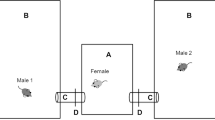Abstract
Twenty-five percent of wild house mice are heterozygous (+/t) for a deleterious, recessive mutation at the t complex. In previous studies we have demonstrated that wild female house mice can discriminate +/+ from +/t males and show strong preferences for the odors of males who do not carry t mutations. In the present study we examine the extent to which preferences of +/+ female mice are influenced by the genotype of their parents and or littermates. Our data indicate that when +/+ females are reared by two +/+ parents, they exhibit strong preferences for the odors of +/+ males. In contrast, when a +/+ female is reared by one +/+ and one +/t parent she shows no preference for males of either genotype. A second experiment using mice carrying recombinant chromosomes indicates that the genes responsible for the parental (or family) odor cue are not the deleterious t mutations per se but rather other genes linked to these mutations.
Similar content being viewed by others
References
Bennett, D. (1975). The T-locus of the mouse.Cell 6:441–454.
Bennett, D. (1978). Population genetics of T/t complex mutations. In Morse, H. (ed.),Origins of Inbred Mice, Academic Press, New York, pp. 615–632.
Bruck, D. (1957). Male segregation ratio advantage as a factor in maintaining lethal alleles in wild populations of house mice.Proc. Natl. Acad. Sci. USA 43:152–158.
D'Udine, B., and Alleva, B. (1983). Early experience and sexual preferences in rodents. In Bateson, P. (ed.),Mate Choice, Cambridge University Press, Cambridge, pp. 311–327.
Dunn, L. C., and Levene, H. (1961). Population dynamics of a variant t-allele in a confined population of wild house mice.Evolution 15:385–393.
Franks, P., and Lenington, S. (1986). Dominance and reproductive behavior of wild house mice in a seminatural environment correlated with T locus genotype.Behav. Ecol. Sociobiol. 18:395–404.
Hammerberg, C., and Klein, J. (1975). Linkage diequilibrium between H-2 and t complexes in chromosome 17 of the mouse.Nature 258:296–299.
Hermann, B., Bucan, M., Mains, P. E., Frischauf, A., and Silver, L. (1986). Genetic analysis of the proximal portion of the mouse t complex: Evidence for a second inversion within t haplotypes.Cell 44:469–476.
Lenington, S. (1983). Social preferences for partners carrying “good genes” in wild house mice.Anim. Behav. 31:325–333.
Lenington, S., and Egid, K. (1985). Female discrimination of male odors correlated with male genotype at the T-locus inMus musculus: A response to T-locus or H-2 locus variability?Behav. Genet. 15:53–67.
Lenington, S., Egid, K., and Williams, J. (1988a). Analysis of a genetic recognition system in wild house mice.Behav. Genet. 18:549–564.
Lenington, S., Franks, P., and Williams, J. (1988b). Distribution of t haplotypes in natural populations of wild house mice.J. Mammal. 69:489–499.
Lewontin, R. C. (1968). The effect of differential viability on population dynamics of t-alleles in the house mouse.Evolution 22:262–273.
Silver, L. M., and White, M. (1982). A gene product of the mouse t complex with chemical properties of a cell surface associated component of the extra cellular matrix.Dev. Biol. 91:423–430.
Yamazaki, K., Yamaguchi, G. K., Barnowski, L., Bard, J., Boyse, E. A., and Thomas, L. (1979). Recognition among mice: Evidence from the use of a Y-maze differentially scented by congenic mice of different major histocompatibility types.J. Exp. Med. 150:755–760.
Author information
Authors and Affiliations
Additional information
This work was funded by a grant from the Research Council of Rutgers University.
Rights and permissions
About this article
Cite this article
Lenington, S., Egid, K. Environmental influences on the preferences of wild female house mice for males of differing t-complex genotypes. Behav Genet 19, 257–266 (1989). https://doi.org/10.1007/BF01065909
Received:
Accepted:
Issue Date:
DOI: https://doi.org/10.1007/BF01065909




